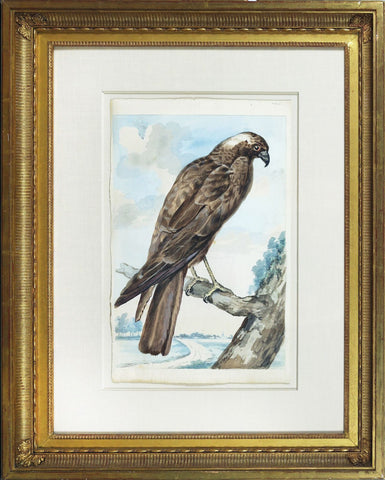
Jacques Barraband (French, 1767-1809), Western Parotia Bird Of Paradise (Parotia Sefilata)
Jacques Barraband (French, 1767-1809)
Western Parotia Bird Of Paradise (Parotia Sefilata)
Prepared for plate 12 of François Le Vaillant’s Histoire Naturelle des Oiseaux de Paradis et des Rolliers, published in 1803.
Watercolor and gouache over black chalk, heightened with gold on paper
Signed in brown ink, lower centre: ‘Barraband f.’ and bears numbering in pencil, lower right: No 19
Paper size: 20½ by 15⅛ in
Provenance: Marcel Jeanson (1885-1942), sale of his collection, Monaco, Sotheby’s, 16 June 1988, lot 225; with W. Graham Arader, New York.
An exquisitely rendered watercolor of the western parotia is a magnificent bird of paradise found only in the mountain forests of northwestern New Guinea. Barraband painted this work in preparation for Plate 12, “Le Silfilet,” in François Le Vaillant’s Histoire Naturelle des Oiseaux de Paradis et des Rolliers, published in 1803.
The male western partoia is shown here displaying his iridescent breast shield and with wiry plumage. Like other birds of paradise, the unusual wiry plumage behind his head is used to attract a female mate in a courtship display. The male performs a ballerina-like “dance” with its elongated black plumes spread around skirt-like, right below the iridescent breast shield, and shakes his head and neck rapidly to show the brilliance of his inverted silver triangle-shaped head adornment.
Levaillant, the son of the French consul in Dutch Guiana, was arguably the greatest and certainly the most prolific producer of comprehensive high-quality bird books in the first quarter of the 19th century. He chose Jacques Barraband for this most spectacular work on exotic birds: Histoire Naturelle des Oiseaux de Paradis et des Rolliers. Barraband’s work for Levaillant undoubtedly marks the high point of his career and makes clear why he was considered the best ornithological artist of his generation.
Of the Silfilet’s unusual plumage, Levaillant dismissed previous accounts of this bird stating that ornithologist lacked the ability to appropriately categorize it and illustrate it accurately. At the time of his publication, he knew of only three examples of this bird in perfect condition in private cabinets. The first was in Amsterdam, the second in Rotterdam, and the third in his own cabinet. He acknowledged that if the reader just saw the drawing he might think the species to be fictitious, so he made his example available for the public to see side by side his plate so “by comparing it to the drawings and engravings made from it” they could understand he was not trying to trick them. The true magnificence of the bird was realized by the great Barrband whom he praised in the text for the corresponding plate to this watercolor,
“O Barraband! You whose faithful brush so powerfully serves my zeal, you whom I have seen so often hesitate, fear not to return the beauties that I expose to your eyes, would you have thought that, with no intention of harming me, we would find that your colors, skillfully distributed, would surpass those of nature!”
The artist’s rendering clearly surpassed the publisher’s expectation, Levaillant noting that he had surpassed his predecessors who merely placed a bird on “stick and without legs, wings or bones in the head.”
Jacques Barraband (french, 1767-1809)
Jacques Barraband’s watercolors of birds are masterpieces of French ornithological illustration. Most of his stunning portraits were done for the distinguished ornithologist Francois Levaillant, who commissioned the artist to illustrate his landmark works on African ornithology, including the lavish and striking Histoire Naturelle des Perroquets. Images of African birds were popular in early 19th-century France both for their exoticism and for Africa’s interest that Napoleon’s campaigns were generating. The collaboration of Levaillant and Barraband represented a departure from previous ornithological texts in its emphasis on beauty and luxury, with sumptuously colored and flawlessly rendered birds.
The project was a massive undertaking, which required over 300 finished watercolors. Apart from their undoubted beauty, they display a scientific accuracy that few ornithological artists have matched since. Still, the meticulous hand-colored engravings in Levaillant’s publications could not reach the delicate modulations of tone and color, the fine lines, and perfect draftsmanship of Barraband’s original watercolors, which are exceptional in their richness and tonal variation. Each feather is described by dozens of parallel lines, providing remarkable detail and naturalistically textured color.
The key to Barraband’s renown was his success as an illustrator of luxurious bird books. In addition to illustrating Francois Levaillant’s Histoire naturelle des perroquets (1801-05), Barraband also executed the original watercolors for the ornithologist’s Histoire naturelle des oiseaux de paradis (Birds of Paradise, 1801-06). These splendid watercolors demonstrate Barraband’s unparalleled ability to render splendidly realistic images of exotic birds of all forms.
Barraband studied under Joseph Malaine and afterward worked as a draftsman in the Gobelin tapestry works. He painted porcelains exhibited at the Paris Salons from 1798 through 1806, and records at Sevres show that he supplied drawings to the factory there in 1806. He also decorated the dining-room in Napoleon’s chateau at St. Cloud. His work for Francois Levaillant was undoubtedly the climax of his career. His drawings for Levaillant’s splendid works placed him at the forefront of French ornithological artists at the beginning of the 19th century. As these flawless watercolors demonstrate, Barraband combined a high order’s artistic ability with good taste and a rare aesthetic sense.
or by email at loricohen@aradergalleries.
We Also Recommend





